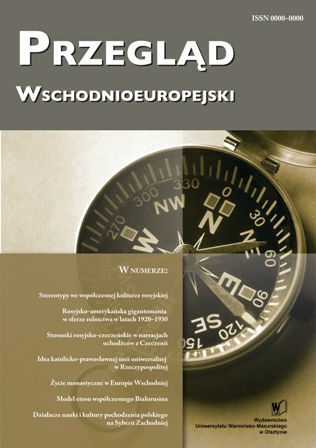Stosunki gospodarcze i handlowe ZSRR – Niemcy w latach 1918–1940 (część 1)
Economic and trade relations between the USSR and Germany in the period of 1918–1940 (part 1)
Author(s): Zbigniew KlimiukSubject(s): Economy, Political history, Social history
Published by: Wydawnictwo Uniwersytetu Warmińsko-Mazurskiego w Olsztynie
Keywords: Soviet Union; Germany; foreign trade; trade relations; trade agreement; trade turnover; export; import; trade representation; custom tariffs and quotas
Summary/Abstract: The author analyzes in his paper the economic and trade relations between Germanyand the Soviet Union in the period of 1918–1944. During this period trade relations withGermany constituted a continuation of relations between Tsarist Russia and Germany beforeWorld War I. The German-Soviet Economic Agreement of October 12, 1925, formed specialconditions for the mutual trade relations between the two countries. In addition to the normalexchange of goods, German exports to the Soviet Union were based from the very beginningon a system negotiated by the Soviet Trade Mission to Berlin under which the Soviet Union wasgranted loans for financing additional orders from Germany. Trade with Soviet Union, promotedby the first credit-based operations, led to a dynamic exchange of goods, which reached itshighest point in 1931. In the early 1930s, however, Soviet imports decreased as regime assertedpower and its weakened adherence to the disarmament requirements of the Treaty of Versaillesdecreased Germany’s reliance on Soviet imports. In addition, the Nazi Party’s ascent to powerincreased tensions between Germany and the Soviet Union. In the mid-1930s, the Soviet Unionmade repeated efforts at reestablishing closer contacts with Germany. The Soviets chieflysought to repay, with raw materials, the debts which arose from earlier trade exchange, whileGermany sought to rearm, therefore both countries signed a credit agreement in 1935. The saidagreement placed at the disposal of the Soviet Union until June 30, 1937, the loans amountingto 200 million Reichsmarks, to be repaid in the period 1940–1943. The Soviet Union used183 million Reichsmarks from this credit. The preceding credit operations were, in principle,liquidated. Economic reconciliation was hampered by political tensions after the Anschluss inmid-1938 and Hitler’s increasing hesitance to deal with the Soviet Union. However, a new periodin the development of Soviet–German economic relations began after the Ribbetrop–MolotovAgreement, which was concluded in August of 1939.
Journal: Przegląd Wschodnioeuropejski
- Issue Year: IX/2018
- Issue No: 1
- Page Range: 49-64
- Page Count: 16
- Language: Polish

